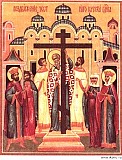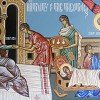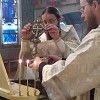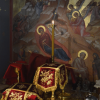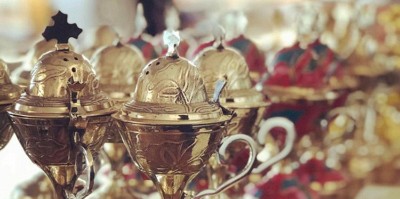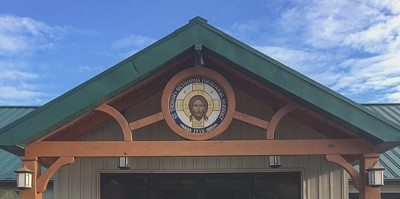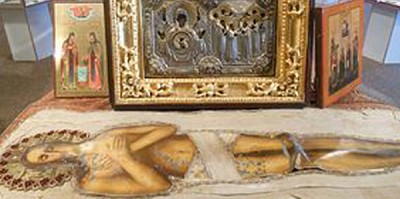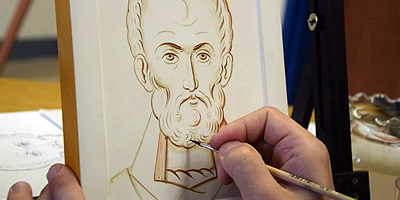'Lord save Thy people and bless Thine inheritance...'
O Lord, save Thy people, and bless Thine inheritance. Grant victories to the Orthodox Christians over their adversaries; and by virtue of Thy Cross, preserve Thy habitation.
Troparion of the Feast
Not long after the Nativity of the Most-Holy Theotokos, the Church celebrates the Exaltation of the Most-Precious Cross of the Lord. The Savior Himself had spoken of His death on the Cross, saying: As Moses lifted up the serpent in the wilderness, so must the Son of man be lifted up, that whoever believes in Him may have eternal life. For God so loved the world that He gave His only Son, that whoever believes in Him should not perish but have eternal life (John 3:14-16). This was accomplished on Holy Friday when the Lord was “crucified under Pontius Pilate, suffered and was buried,” as the Creed proclaims. And just before He died He proclaimed It is finished (John 19:30).
Truly, the Nativity of the Theotokos was seen as the beginning of our salvation, and the Cross is seen as the culmination of our salvation. By Christ's death on It, our salvation was accomplished. Mary is also closely associated with the Cross, for she was the “mystical paradise” in whom the Tree of Life sprouted; this Tree of Life, Christ our Savior, then “planted on earth the life-creating Tree of the Cross” (from the Feast). And as He suffered and died on the Life-giving Tree of the Cross, so too we are called upon to take up our own crosses on our shoulders and to die daily for the sake of Him Who died for us.
The Feast itself came about because of certain historical events. After the voluntary suffering and death on the Cross of the Lord, the sacred place of His suffering was scorned by the pagans. When the Roman Emperor Titus, in 70 A.D. conquered Jerusalem, he destroyed the city and leveled the Temple on Mt. Moriah, not leaving even a stone upon a stone, as had been foretold by the Savior in a dialogue with His disciples (Mark 13:1-2).
The Emperor Hadrian (117-138), a backward, zealous pagan, constructed in place of the Jerusalem destroyed by Titus a new city, which he named Helio-Hadrianopolis. Further, it was forbidden for this city to be called by its previous name of Jerusalem. He commanded that the Holy Grave of the Lord be covered with earth and stones, raising on it an idol. On Golgotha, where the Savior was crucified, in 119 he erected a temple dedicated to the goddess Venus. Sacrifices were offered before the statue and pagan rites were celebrated, accompanied by prostitution. In Bethlehem, in the place where the Savior had been born of the Most-Pure Virgin, the impious monarch erected an idol to Adonis. All of this he did intending that the people completely forget about Christ the Savior and nevermore recollect the place where He lived, taught, suffered and arose with glory.
When Constantine the Great, Equal-to-the-Apostles (306-337) ascended the throne (being the first of the Roman Emperors to recognize Christianity) , he, together with his pious mother, Queen Helena, decided to restore the city of Jerusalem, and in the place of the suffering and resurrection of the Lord Jesus Christ to erect a new church, to cleanse all of the places connected with the memory of Jesus from the pagan cult, and again to consecrate all of them. The Orthodox Queen Helena left for Jerusalem with a great quantity of gold, and the Emperor sent a letter to Patriarch Macarius I (313-323) in which he asked every kind of aid in the holy task of restoring the Christian holy places.
Having arrived in Jerusalem, the pious Queen destroyed all the idols and cleansed the city of pagan cult objects, consecrating the defiled places. She burned with the desire to raise up the Cross of Our Lord Jesus Christ; and so she commanded that digging proceed at the place where the Temple of Venus had stood. There the covered Grave of the Lord was discovered, as well as the place of execution, not far from which were found three crosses and four nails, as well as the sign board which had been nailed over His head.
In order to determine which of the three crosses belonged to the Savior, Patriarch Macarius ordered that the crosses, in turn, be placed on a dead person who was being brought to a place of burial. When the Cross of Christ touched the dead one, he immediately came to life. With great joy, the Orthodox Queen and the Patriarch together lifted up the Life-Creating Cross and showed it to all the people standing by. Later the Church of the Holy Sepulcher was constructed on the site, enclosing within its walls the place of the crucifixion of the Savior, as well as His tomb, and a Feast was instituted for September 14, commemorating the glorious Exaltation of the Cross.
- Excerpt from These Truths We Hold
As Thou wast voluntarily crucified for our sake, grant mercy to those who are called by Thy Name; make all Orthodox Christians glad by Thy power,
granting them victories over their adversaries, by bestowing on them the invincible trophy, Thy weapon of peace.
Kontakion of the Feast
|
| |||||||||||||
175 St. Tikhon's Road
Waymart, PA 18472
Sun
9MarTriumph of Orthodoxy
9:10 Hours and Divine Liturgy
4:30 Vespers & Small ComplineMon
10Mar6:00 Midnight Office, Matins, Hours
4:30 9th Hour, Typica, Vespers, Great ComplineTue
11Mar6:00 Midnight Office, Matins, Hours
4:30 9th Hour, Typica, Vespers, Great Compline

